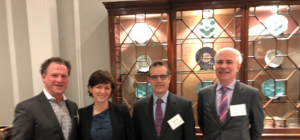Too often, some practicing professionals leave clients mesmerized by their technical knowledge rather than making them feel informed and confident.
In my experience, advisors earn client trust not by wowing them with their technical knowledge but by their skill at communicating effectively with them.
This involves advisors taking on several roles during a conversation, meeting or relationship with their clients: social worker, therapist, peacekeeper, facilitator and most importantly, trusted advisor.
Four leaders from Canada’s financial and legal industries offered their road-tested tips for reaching successful business outcomes, largely as the result of managing difficult conversations. They took part in a recent panel discussion at Toronto’s National Club and included:
Margaret Franklin
President
BNY Mellon Wealth Management, Advisory Services
Colin Walker
Managing Director
Crosbie & Company
Michael Henry
Managing Partner
Houser Henry & Syron LLP
Moderator: Jeff Noble
Director, Business & Wealth Transition
Private Client Services
BDO Canada

Jeff Noble; @BDO_Canada
Margaret Franklin; @BNYMellonWealth
Colin Walker; Crosbie & Co
Michael Henry; @HouserHenry
Here are some tips for advisors on guiding families to sound business and wealth planning decisions, while showing stakeholders respect, professionalism and resolve.
Ask meaningful questions of clients early in the process to help identify underlying problems
(Clients’ honest answers to the “hard questions” may not flow easily but will ultimately help them reach their goals. These are the most important questions the advisor can ask.)
Colin Walker:
Be prepared to occasionally take on the role of social worker and listen actively. Take the time to understand each stakeholder’s point of view and help him or her find their voice in the negotiations at hand
Asking questions of clients early in the process can help identify underlying problems. Identifying these problems can constitute 80 per cent of the solution. (Walker and his team spent 50 hours interviewing stakeholders on a file to get a better sense of each person.)
Their answers can help the advisor to guide families in the creation of a common vision that will provide a rudder to create alignment and keep the conversation going.
Build a common vision for all stakeholders by not making assumptions at the start
(Seasoned advisors embrace the fact that there is no quick fix and no two situations are identical.)
Michael Henry:
A common vision occurs when leaders don’t make assumptions. They take the time to canvas stakeholders to understand the issues as they are, not as they perceive them.
Clients are more receptive to an advisor who sees their succession or business sale challenge as unique. Advisors sometimes make assumptions in trying to resolve a matter by accelerating the information gathering process. They miss the opportunity to create an even better solution based on a common vision.
Margaret Franklin:
As leaders, we are not cheerleaders who offer a “Rah, rah” approach. We are professionals who help stakeholders stay on track while feeling heard and respected. To give them a voice, we must encourage them to share their feelings and concerns. This takes time and the will to avoid making assumptions, even if we have advised on similar situations.
After a liquidity event, family differences may linger and the advisor needs to help all stakeholders find and maintain their voice at the table.
There is no such thing as a “one and done” where a succession or wealth management process is involved. Building a common vision is an ongoing process in which stakeholders get used to living with the outcomes, however positive.
Creating collaboration among stakeholders can be messy but it’s essential to a successful outcome
(Personality conflicts and long-standing grudges, feelings of self-entitlement and diverse views on the future of the business can divide families. Finding a common thread that brings them together is one the advisor’s toughest tasks).
Michael Henry:
Fostering collaboration among stakeholders often involves encouraging owners to step away from their “action-oriented stance”, which has helped drive their business forward. Collaboration (including among advisors) helps to ensure all stakeholders have a voice in shaping the family’s legacy, free from the influence of a powerful patriarch or matriarch who had previously dictated how the business was run.
Collaboration can be messy and takes:
- Patience
- Candour to address the “elephant in the room” – and deal with it
- Persistence on the advisor’s part who must have a thick skin and plenty of grit to lead the family to a better place
- Understanding on the part of all advisors that human issues will stand in the way of logical decision making and need to be addressed
- A positive attitude
- Frequent check-ins with clients who often don’t even consider a succession plan until it’s late in the game. That is when “wealth creators” can quickly become “wealth destroyers”.
Encourage clients to create their own family councils
(Family councils are most effective when built on trust and a shared resolve to find the best solution for all stakeholders – present and future.)
Colin Walker:
Creating a family council can be a positive forum for encouraging family discussion, but may not be a panacea. Stakeholders may still have embedded personal differences that are difficult to change after many years of being part of family business and personal dynamics. Making a family council work well involves meeting at times agreed upon in advance, full stakeholder attendance, and creation of an agenda and minutes by a family member or a qualified and objective third party. It can also involve an advisor who can facilitate the conversation.
Margaret Franklin:
When creating a family council, remember that good facilitation involves everyone and is critical to a successful outcome. A true family council involves different generations with personal goals and views of their future. For example, I have observed that by aged 70, stakeholders are often very concerned about mortality and their legacy. By the age of 75, they often feel it is too late to make any changes to their personal situation or nature of their legacy.
Michael Henry:
Creating a family council (in the Rothschild tradition) takes time and effort to create but can help smooth differences and establish a common vision.
Be mindful of including everyone at the table, even before the meeting begins
(When meeting participants feel engaged and heard in the crucial minutes after they enter the room, they will be more likely to participate fully in the business conversation that follows.)
Margaret Franklin:
The person who opens the conversation around the table owns the room. “Small talk” relaxes people as they establish common ground. It should be inclusive and go beyond, for example, two or three people talking about golf while non-golfers in the room sit quietly and feel distant. Consider opening a conversation with one participant by asking, “What has captured your imagination lately?” or, “What have you accomplished recently that makes you proud?” This will encourage others to participate and bring warmth and trust to the room, which will allow for a more productive conversation.
Invest time in debriefing with your team after a stakeholder meeting. Invite their observations on stakeholder body language and other personality traits that you may have missed in your role as meeting facilitator and host.
Choose language and communication styles that resonate with each stakeholder
(Speaking “down” to stakeholders does more harm than good in ensuring clients’ comprehension of technical concepts. Consider using conversational or plain language (with brief examples or stories) to make your point.)
Jeff Noble:
The outcome (good or bad) of any communication is based on the message received, not the message sent. Face-to-face meetings are critical to building trust and online communication can be rife with challenges when the stakes are high. For example, stakeholders conducted a recent $6 billion transaction involving many people in different locations – without one face-to-face meeting throughout the process. Needless to say, the outcome was a poor one as the stakeholders were never really in synch, in part owing to their choice of communication. Building stakeholder trust among advisors and stakeholders relies on clear communication.
Margaret Franklin:
Advisors who are more technically oriented do better when they leave the jargon behind and communicate in a way that relaxes stakeholders and encourages their input and questions. Simplicity and clarity are more effective than complicating the issue with technical messages that confuse the audience.
I avoid taking the “artificial intelligence” approach to communicating in stakeholder meetings. I watch for subtle changes in speech patterns and body language to make sure I am connecting with my audience. Language that reflects stakeholders’ style of receiving messages is critical, as men and women often have different approaches to communicating and problem solving.
